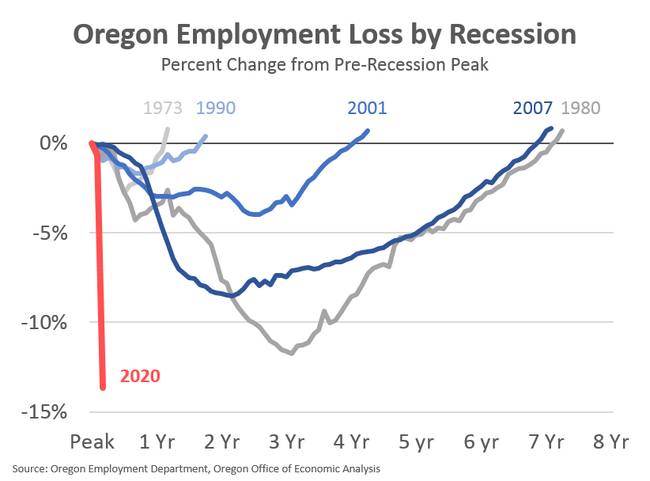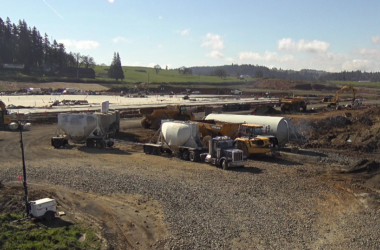
A graph from the Oregon Employment Department, released May 19, illustrates job losses during previous recessions and how they compare to the current economic downturn. (Courtesy/Oregon Employment Department)
The Salem area unemployment rate took an unprecedented one-month jump from March to April of more than nine points, due to the economic lockdown to contain the coronavirus. It was 13.3 percent in April, a record high.
Consider that in the last recession Salem’s unemployment rate took 16 months to increase six percentage points, and in the Great Depression of the 1930s, the U.S. rate took three years to increase 16 points.
This huge one-month jump has caused complications for the economists who calculate the rate. It will take months to see real trends, and explaining the rate and the complications will help us see why.
The unemployment rate is the number of unemployed, aged 16 and over, divided by the number of those in the civilian labor force, and expressed as a percentage. To be considered unemployed, an individual must be out of work, available for work, and making efforts to find work. An individual is in the labor force if they are working, or looking for work.
The federal Bureau of Labor Statistics produces the unemployment rate with a survey of 110,000 individuals. The survey takes place monthly, in the week with the 12th in it (this will become important later on). Survey results classify an individual’s work status as unemployed, employed, and in or not in the labor force.
Beginning in April, at least two problems arose in interpreting survey responses. Those expecting to be called back to work from a layoff are counted as unemployed, and the number of these individuals skyrocketed In April and May. This was no doubt related to the sudden shutdown, but survey responses didn’t clearly indicate this.
The second problem was with those classified as employed during the survey week, but absent from work for any of six reasons. The number of these individuals took a huge jump from March to April, likely related to the shutdown.
The federal labor statistics agency noted that it was likely that most of these individuals should have been classified as unemployed and on temporary layoff. The agency left them classified as “employed” however, to preserve survey integrity.
To try to get a clearer picture of how the closure is affecting the unemployment rate, the federal agency added five pandemic-related questions to the survey beginning in May. Interviewers are also being given guidance related to several questions including “Is there any indication you will return to work within six months?” When responders are uncertain, interviewers are instructed to enter a response of “Yes, I am expecting to return to work” rather than “I don’t know”. This will allow these individuals to be counted as unemployed.
The survey produces unemployment rates for the U.S. and Oregon. For areas like Salem, the number of survey responses producing the rate is very small, so other economic indicators, such as unemployment claims, are factored in.
Fewer survey responses, and the volatility of these factors due to large one-month changes, has made local area unemployment rates “challenging to calculate” according to Pat O’Connor, Oregon Employment Department’s Salem area economist.
What does all this mean? For starters, we have two months of a pandemic-related unemployment rate for the U.S. and it declined by more than 1% from April to May. This could mean that some of those on temporary layoff went back to work.
But we won’t know for sure until the survey fully incorporates the reality of pandemic-related unemployment into its survey methods.
What about local rates? The Oregon unemployment rate for May will be published on Tuesday, June 16, and the Salem rate on Tuesday, June 23. Will these rates decline as the U.S. rate did?
Here’s where the 12th day of the month matters. The May survey was done in Oregon and Salem before the “phase one” re-opening, when some closed businesses were allowed to open and restaurants and bars could provide fuller service.
The Oregon and Salem rate may not come down for this reason, but we’ll have to wait and see.
There’s more to analyze about how this extraordinary economic situation will affect Salem. Here are just a few examples: the largest job losses in Salem from March to April were in leisure and hospitality, paying the lowest wages of any industry in the Salem area; half of state government employment is in Salem and state revenue collections are taking brutal losses; and the Salem downtown just lost a major retailer that had been there for decades.
What will the short and long-term impacts of this pandemic-related recession be on Salem’s economy? Stay tuned for more analysis in future columns.
Questions? Pam Ferrara is a researcher with the Willamette Workforce Partnership, focusing on the local economy and labor market issues. [email protected]
SUPPORT SALEM REPORTER’S JOURNALISM – A monthly subscription starts at $5. Go HERE. Or contribute to keep our reporters and photographers on duty. Go HERE. Checks can be sent: Salem Reporter, 2925 River Rd S #280 Salem OR 97302. Your support matters.









